New episode of Behind the Process features Loma Linda University Health’s creative leaders sharing their secrets for balancing flexibility with structure
In the latest episode of Behind the Process, host Will Goad sits down with two seasoned creative professionals from Loma Linda University Health: Jhanelle Zurbano, Manager of Design Services, and Dawn Chilson, Project Graphic Designer. With nearly 15 years at the organization, Jhanelle and her team have mastered the art of delivering everything from web banners to billboards while maintaining quality and meeting impossible deadlines.
What Makes This Team Tick
The Loma Linda design team is what Jhanelle calls “small but mighty” – just six designers handling the creative needs of a massive healthcare and university organization. They serve everyone from individual doctors and clinics to university deans and school programs, creating marketing collateral that spans the entire spectrum of design work, including digital, web, and print.
But here’s what makes them special: they’ve figured out how to be both systematic and flexible, no small feat in the fast-paced world of healthcare marketing.
Key Highlights from the Conversation
The Power of Flexible Templates
One compelling insight from the episode is how the team handles the inevitable “rush job.” Rather than throwing their processes out the window when urgency strikes, they’ve created specific workflow templates for different scenarios – including a dedicated rush template that “supersedes everything else.”
As Dawn explains, this approach allows them to maintain quality and communication standards even when timelines compress dramatically.
Solving the “Hurry Up and Wait” Problem
Anyone who’s worked in creative services will recognize the challenge Jhanelle describes as “hurry up and wait” jobs – projects that start as urgent but then sit waiting for approvals. Their solution? Building accountability and visibility into every step of the process.
The team has implemented systems for automatic reminders, centralized communication through project notes, and multiple levels of review that can be adjusted based on the project’s needs.
Documentation as a Superpower
Both Jhanelle and Dawn emphasize the critical importance of writing everything down. They’ve created comprehensive process documentation that serves multiple purposes:
- Reduces repetitive training and questions
- Provides backup when team members are unavailable
- Creates a foundation for continuous improvement
- Establishes clear expectations for stakeholders
The Big Takeaways
- Standards + Flexibility = Success The team has learned that rigid processes break under real-world pressure, but complete flexibility leads to chaos. Their sweet spot is having strong standards that can be adapted as needed.
- Transparency Builds Trust By giving stakeholders visibility into workflows and project status, they’ve reduced friction and helped clients understand the complexity of what the team manages daily.
- Centralized Communication is Non-Negotiable. Moving all project communication into a single platform eliminates the scattered conversations across email, chat, and phone calls that often derail creative projects.
- Team Empowerment Through Documentation When processes are documented and accessible, team members can solve problems independently and leadership isn’t a bottleneck.
Why This Conversation Is Important
Whether you’re managing a creative team, implementing new project management systems, or trying to balance client demands with realistic timelines, this conversation offers practical strategies you can implement immediately.
Jhanelle and Dawn’s approach proves that you don’t need perfect processes – you need adaptable ones. Their willingness to continuously refine their workflows while maintaining core standards has allowed them to scale their impact without scaling their team size.
Listen to the full episode to hear more about their specific strategies for managing resource utilization, setting up review hierarchies, and maintaining team morale during high-pressure periods.




